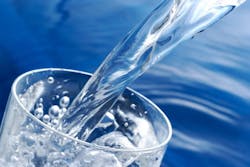Manganese in Drinking Water: What It Is, How It Gets There, and More
What Is Manganese?
Manganese is a mineral that occurs naturally in the earth’s crust. It’s often found in combination with other minerals, like iron.
Manganese is found in tiny amounts of the body and supports bone and tissue health. The mineral also helps with blood clotting and nerve function and plays a role in carbohydrate and fat metabolism, and blood sugar regulation.
Although trace amounts of manganese are essential for good health, too much manganese can contribute to muscle pain, nerve damage and fatigue.
How does Manganese Get Into Drinking Water?
Manganese is naturally occurring in rocks and soil, so it gets into groundwater that seeps through the earth, collecting minerals.
Manganese pollution is also a potential cause of manganese in drinking water. Manganese is used as an additive in gasoline and is released into the environment in exhaust gases.
How to Know if your Water Contains Manganese
Manganese is rarely found alone in water. It’s rarer than iron, so you’re unlikely to find manganese alone, without iron, in your water. If you know your water contains iron, there’s a good chance that it also contains manganese.
Signs of manganese in drinking water supplies include:
- An orangey-brown tint
- Orange or brown staining on surfaces that come into contact with water
- Metallic taste or smell
- Dark black or brown stains on laundry
Potential Effects of High Manganese Levels in Drinking Water
Some of the most common health and aesthetic impacts of high levels of manganese in water are:
- Cognitive problems: Adults and children who drink high levels of manganese for prolonged periods are at risk of cognitive problems including motor, memory and attention issues.
- Manganese toxicity: Drinking water with very high levels of manganese can cause manganese toxicity, with symptoms including muscle tremors, insomnia, mania, hearing problems, loss of appetite, depression, irritability, headaches and weakness.
- Dark brown or black stains: The most common aesthetic manganese issue is staining. Manganese leaves dark brown or black stains on showers, sinks, bathtubs, laundry, and plumbing fixtures.
- Poor-tasting water: Manganese has a distinct metallic taste and aroma. Drinking water containing manganese tastes unpleasant, and cooking with manganese-contaminated water imparts a metallic flavor to foods.
Manganese EPA Regulations
Manganese is regulated by the US Environmental Protection Agency (EPA) in public drinking water supplies due to its staining ability. There are no legal enforcements set by the EPA for manganese, however, manganese simply has an SMCL (secondary maximum contaminant level) of 0.05 mg/L.
What does this mean? Public water systems aren’t legally required to adhere to these EPA guidelines. This means that many water supplies in the US have a higher manganese content than the EPA’s SMCL.
Manganese in Well Water
Well water isn’t regulated by the EPA at all. While public water systems typically filter minerals like manganese down to trace levels, private wells don’t receive pre-treatment, so they commonly have a much higher mineral content than public drinking water.
It’s the well owner’s responsibility to test for impurities like manganese and filter these contaminants from their water.
How to Remove Manganese from Drinking Water
The best way to remove manganese from drinking water is to use an at-home water treatment system.
Air Injection Oxidation Filtration
Air injection oxidation filtration is the best solution for well water containing a combination of iron, manganese and hydrogen sulfide (three minerals that are often found together).
An air injection oxidation filter uses a tank with an air bubble at the top. When water flows through the air bubble, the minerals - including manganese - are oxidized. These minerals are then trapped in a bed of manganese greens and or birm.
When the system backwashes, the minerals are drained out of the media. Air injection oxidation can remove up to 5 ppm of manganese from water.
Cation Exchange
A cation exchange water softener can remove small amounts of manganese from water.
Cation exchange works by exchanging cations (notably calcium and magnesium) to soften water. The main goal of cation exchange is to prevent damage from hardness minerals, but this process can also be used to remove low levels of other minerals, like iron and manganese.
If your water contains high levels of manganese, cation exchange is not the best solution for you.
Reverse Osmosis
Reverse osmosis is an effective way to remove low levels of manganese from city water.
A reverse osmosis system sends water through a semi-permeable membrane and several filter stages, including a sediment filter and a carbon filter. The semi-permeable membrane contains tiny pores that block almost all impurities from passing through to the other side.
More than 90% of manganese can be removed with reverse osmosis. However, this method shouldn’t be used for treating high levels of manganese, as too much manganese blocks and damages the membrane.
Distillation
Distillation is a good option for removing manganese from drinking water.
In the distillation process, water is heated until it boils and evaporates. Minerals like manganese don’t have the same boiling point as water, so they’re left behind in the boiling chamber as water travels through a cooling corridor and condenses into a separate container.
Distillation can remove nearly all impurities from water. However, the disadvantage of this method is that distillation is an incredibly slow process, and can only be used for point-of-use applications, so it won’t resolve a manganese issue in the entire home.
In Summary
Manganese is a healthy mineral in trace amounts, but too much manganese in drinking water can have harmful health effects in damaging effects in your plumbing, appliances, and water fixtures. High levels of manganese are more common in well water supplies than in treated public drinking water.
The best way to remove manganese from well water is with air injection oxidation. Distillation and reverse osmosis are two of the best ways to remove manganese from city water supplies.
